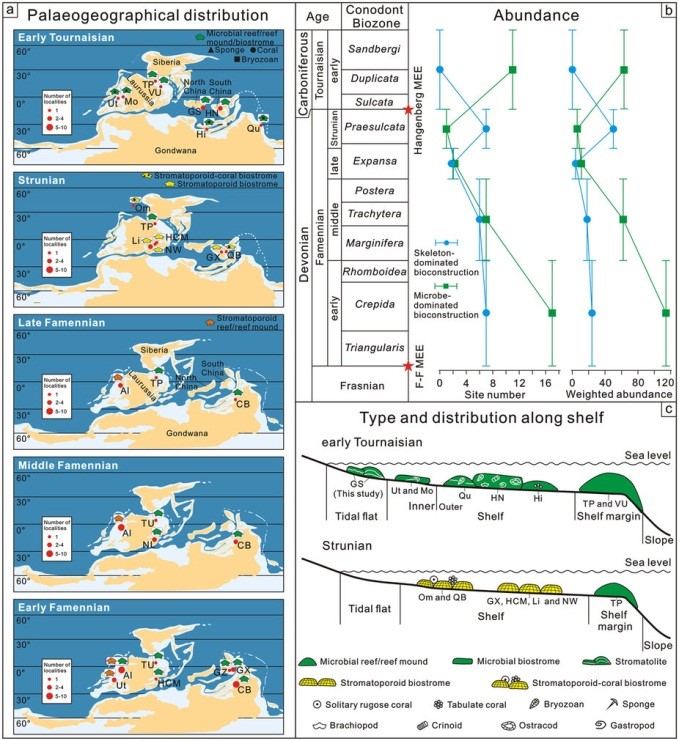
A severe mass extinction event happened during the Devonian-Carboniferous transition (about 359 Ma heretofore), which causes the extinction of >45% genera and ~21% of marine invertebrate families. Typical sedimentary rocks from the Rhenish Massif, western Germany, are globally distributed (Hangenberg black shale, Hangenberg shale and Hangenberg sandstone in ascending order), resulted from the prominent marine anoxia and global sea-level changes. Hence, this end-Devonian mass extinction event is also named as Hangenberg mass extinction event. Recent comprehensive analyses show that the Hangenberg event lasted from the latest Devonian to the earliest Carboniferous (e.g., ~100-300 kyr; uppermost Lower Siphonodella praesulcata Zone to lowest Siphonodella sulcate Zone).
Microbial carbonates usually flourished after the mass extinction events, taking the end-Permian mass extinction event for example. Proliferation of microbial carbonates was generally attributed to the reduced competition from multicellular organisms after mass extinctions, resulted in lower levels of grazing and/or bioturbation of microbial communities. In addition to metazoan competition, flourishing microbial carbonates were also supported by a high seawater calcite saturation state (SCSS), which must have enhanced microbial calcification and carbonate production. The decline of marine metazoans and the SCSS in that time is much higher than those in the Early Triassic during the Hangenberg extinction. Therefore, microbial carbonates should have thrived in the early Tournaisian. However, the documented bioconstructions dominated by stromatolites and/or thrombolites to date are rare, and can only be found in Australia.
Skeletal and microbial reef ecosystems are two opposite elements of the marine biosphere, which could be used to unravel the marine ecosystem evolution during the mass extinctions. In order to unravel the changes in the marine biosphere across the Hangenberg extinction, Dr. YAO Le, Prof. WANG Xiangdong, and Dr. CHEN Jitao from NIGPAS, Prof. ARETZ Markus from the University of Toulouse III and Prof. WEBB Gregory E. from the University of Queensland, recently studied the stromatolites from Northwest China in great detail. The materials came from the Qianheishan Formation at the Dashuigou section in Ciyao area, Pingchuan County, Gansu Province, NW China, containing volume of rock 200 m in width and 16 m in thickness. The age of the stromatolites is constrained to the earliest Carboniferous, which is equal to the conodont zone of lower Siphonodella sulcate, based on the comprehensive analysis of ammonoid, ostracod and palynological biostratigraphy. In addition, the bryozoan and brachiopod fossils, the fine-scale laminations and the fenestral structures in the Qianheishan stromatolites suggest that they formed in the normal marine environment. Hence, the stromatolites described in this study are the production of marine microbial proliferation after the Hangenberg event. The Qianheishan stromatolites are mainly composed of micrite, peloids, small oncoids, and sparry calcite, which are formed by the microbial baffling, binding and calcification. Three stromatolite morphology types are distinguished, including laminar, wavy-laminar and domal forms. With other early Tournaisian microbe-dominated bioconstructions extensively distributed on shelves, the Qianheishan stromatolites support an event of microbial carbonate proliferation after the Hangenberg extinction. In order to confirm this hypothesis, a lot of quantified study of the microbe-dominated has been taken systematically. The result embraced the hypothesis that the marine biosphere has been significantly modified, changing from the stromatoporoid-coral reef ecosystem to microbial ecosystem. In the early Tournaisian, the microbe-dominated bioconstructions were globally distributed in western America, eastern Russia, eastern Australia, northern India and northwestern and southern China (between 40° latitude on both sides of the paleoequator) and that their abundance increased more than ten-fold in the early Tournaisian compared to the latest Devonian (Strunian). This result indicates that the microbial carbonate proliferation occurred after the Hangenberg mass extinction event.
The proliferation of the microbial carbonates following the Hangenberg extinction event is related to the declined metazoan diversity and the increased calcification rates. However, it remains unclear that which of the two controlling factors is dominant. Reconstruction of the relative abundance of skeleton- and microbe-dominated bioconstructions is a new insight to solve this problem. For this purpose, the changes in the relative abundance of skeleton- and microbe-dominated bioconstructions during the Hangenberg and “Big Five” mass extinctions, respectively, are constructed. Comparing them to the reality, we found that the increase of the abundance of microbe-dominated bioconstructions is consistent with the decline of skeleton-dominated bioconstruction abundance after mass extinctions, implying that the abundance of skeletal bioconstructors plays a crucial role in regulating the proliferation of microbial carbonates in the aftermath of mass extinctions.
This paper was published in Scientific Reports and financially supported by the National Natural Science Foundation of China, the Strategic Priority Research Program (B) of the Chinese Academy of Sciences and the Ministry of Science and Technology Foundation Project and the Centre national de la recherche scientifique (CNRS) Project.
Reference: Yao, L., Aretz, M., Chen, J.T., Webb, G.E., Wang, X.D., 2016. Global microbial carbonate proliferation after the end-Devonian mass extinction: Mainly controlled by demise of skeletal bioconstructors. Sci. Rep. 6, 39694; doi: 10.1038/srep39694.
.....CONTENTS OF PALAEONEWS NO.4.....
